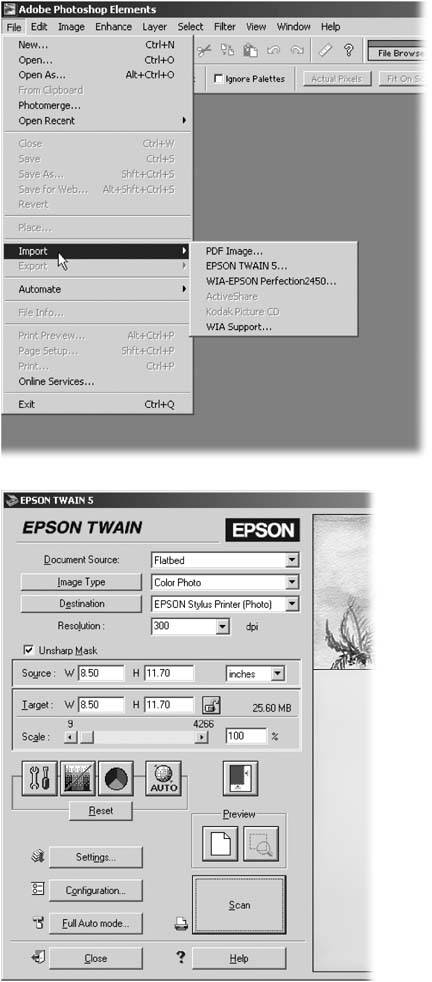6.3. Three Ways to Scan an Image Chances are, your PC lets you control your scanner in three different ways: using Windows built-in scanning wizard; using your graphics program's own menus ; or using the scanner's own software. Here's the rundown on each method and when to select it. -
Windows XP's Scanner and Camera Wizard . This wizard works well for quick, on-the-fly scans : faxing documents, placing images on a Web site, emailing them to friends , or for treating your scanner like a simple copy machine. If you want to summon the wizard when using a graphics program, look for the menu choice labeled WIA, which stands for Windows Image Acquisition. Most programs stick their WIA choices in the File  Import menu. Full details on how to use the scanner wizard start on Section 6.4. Import menu. Full details on how to use the scanner wizard start on Section 6.4. The easy-to-use wizard offers another bonus: the wizard works the same way on every modern scanner. Once you learn the wizard's controls, you can apply those skills to operate the scanner at work or a friend's house, or even on your next scanner. -
TWAIN . Whereas Windows XP's wizard resembles the easy-to-operate, "Point and Shoot" setting on a camera, TWAIN is like switching the camera to "Manual. " Here, you can adjust a scan's size by tenth-of-an-inch increments , save "presets" of custom settings, tweak color values, and perform other adjustments valued by those who need thembut TWAIN's not essential for most jobs. A nonprofit group created TWAIN in the early 90s as a way for software and scanners to talk to each otherquite a feat in those days. Most scanners and graphics software still support TWAIN. For instance, choosing TWAIN in Adobe Photoshop Elements brings up the advanced controls shown in Figure 6-1, which let you tweak settings that the wizard can'thelpful when choosing specific settings requested by a friend, coworker, graphics shop, or a particular piece of software.
Note: Unlike most juxtaposed uppercase letters in TechTalk, TWAIN isn't an acronym. Rather, the words refer to a line in Rudyard Kipling's "The Ballad of East and West:" "And never the twain shall meet." The words summed up the frustration of connecting scanners and PCs in the early 90s.
Figure 6-1. Top: The menus in popular graphics programs like Paint Shop Pro, CorelDraw, and Adobe Photoshop Elements (seen here) let you control your scanner directly in different ways. The Photoshop Elements menu here, for instance, lets you import the attached scanner's images using either TWAIN or WIA (Windows' built-in "wizard").
Bottom: Choosing TWAIN from the Photoshop Elements menu brings up this window, which lets you tweak your scan's color, size, and exposure settings, much like a digital camera's manual controls. If you spot TWAIN listed on your graphics software's menus, select it for a few test scans; you may prefer its controls over Windows XP's built-in scanner wizard.  -
Scanner's bundled software . Although many scanner manufacturers stick with TWAIN controls, others feel they can do better than the Windows wizard or TWAIN's admittedly technical approach. So they write their own set of controllers, usually trying to make things as simple as possible. The result is a program resembling the wizard, with the same ease of use, but adding choices tailored to your specific scanner model. For instance, one scanner's built-in software may offer an option for using an automatic sheet feeder or a Kodachrome slide holder. If the Windows wizard doesn't offer what you need and TWAIN looks too complicated, give the scanner's bundled software a try. The bottom line? If you're happy with Windows XP's built-in wizard scanner controls, stick with it. But if you plan to spend a lot of time with your scanner, give each method a try; they each put a different steering wheel on your scanner. FREQUENTLY ASKED QUESTION
Will OCR Recognize My Recipes? | | I have lots of recipes that I'd like to store on my computer, but I don't want to type them all in. Will a scanner's Optical Character Recognition feature do the job? That depends on lots of things, including the age of the documents you're scanning, the type of paper they're printed on, and any imperfections on the page (say, splattered sauce). Many scanners come bundled with specialized OCR software that examines the dots of a scanned page, locates individual letters, and attempts to save the results as text. The best OCR programs can slurp in a page of neatly printed text nearly flawlessly, only occasionally making a mistake (reading a word like "corn" as "com," for example). But since documents like recipes rarely come on neatly printed pages, expect problems. OCR stumbles over small print, wrinkled paper, and aged newspaper clippings. Since the software can't recognize handwriting, it won't catch your scribbled note reminding you to use less salt next time. Finally, OCR also has trouble with mathematical symbols, so it probably won't understand measurements like "3 1/2 cups of flour." Scan a few recipes, and time yourself while proofreading and correcting the errors. Weigh that time against your typing speed, and you have your answer. |
 |
 Import menu. Full details on how to use the scanner wizard start on Section 6.4.
Import menu. Full details on how to use the scanner wizard start on Section 6.4. 